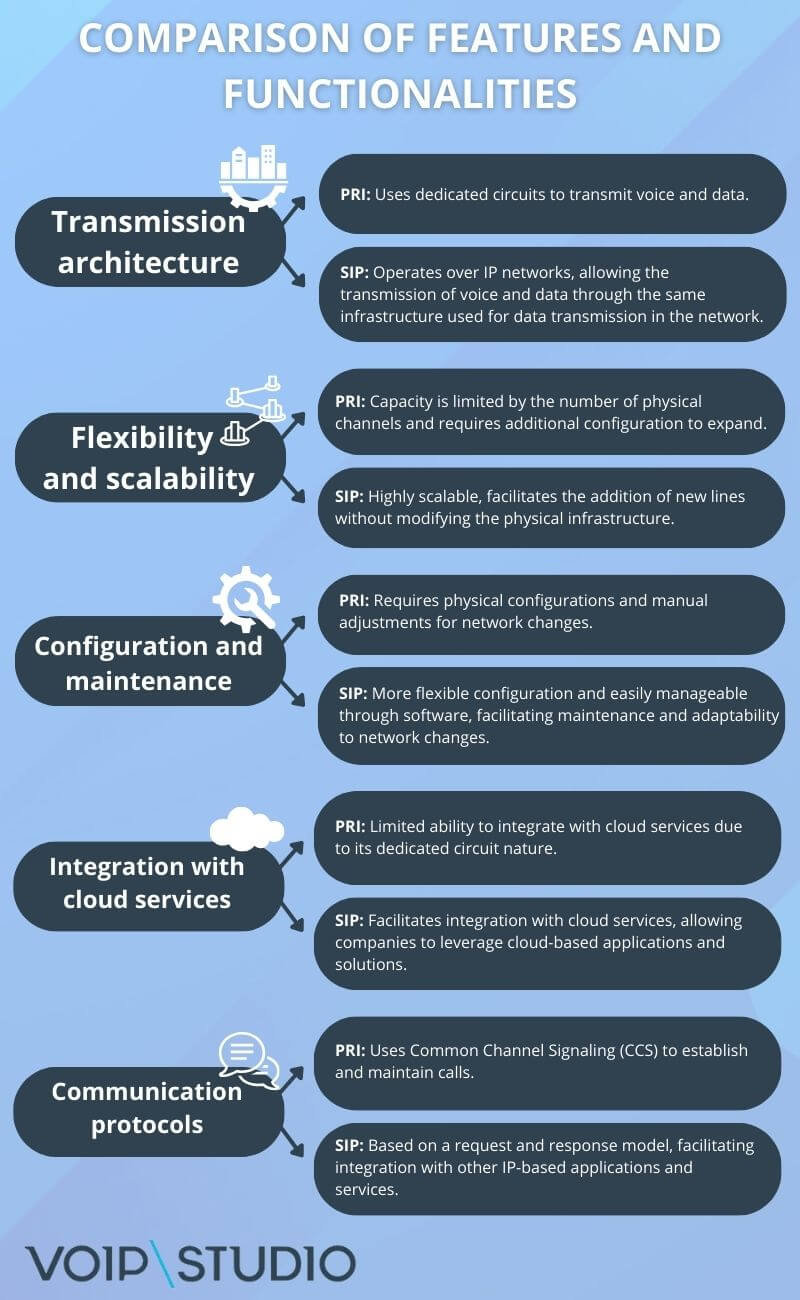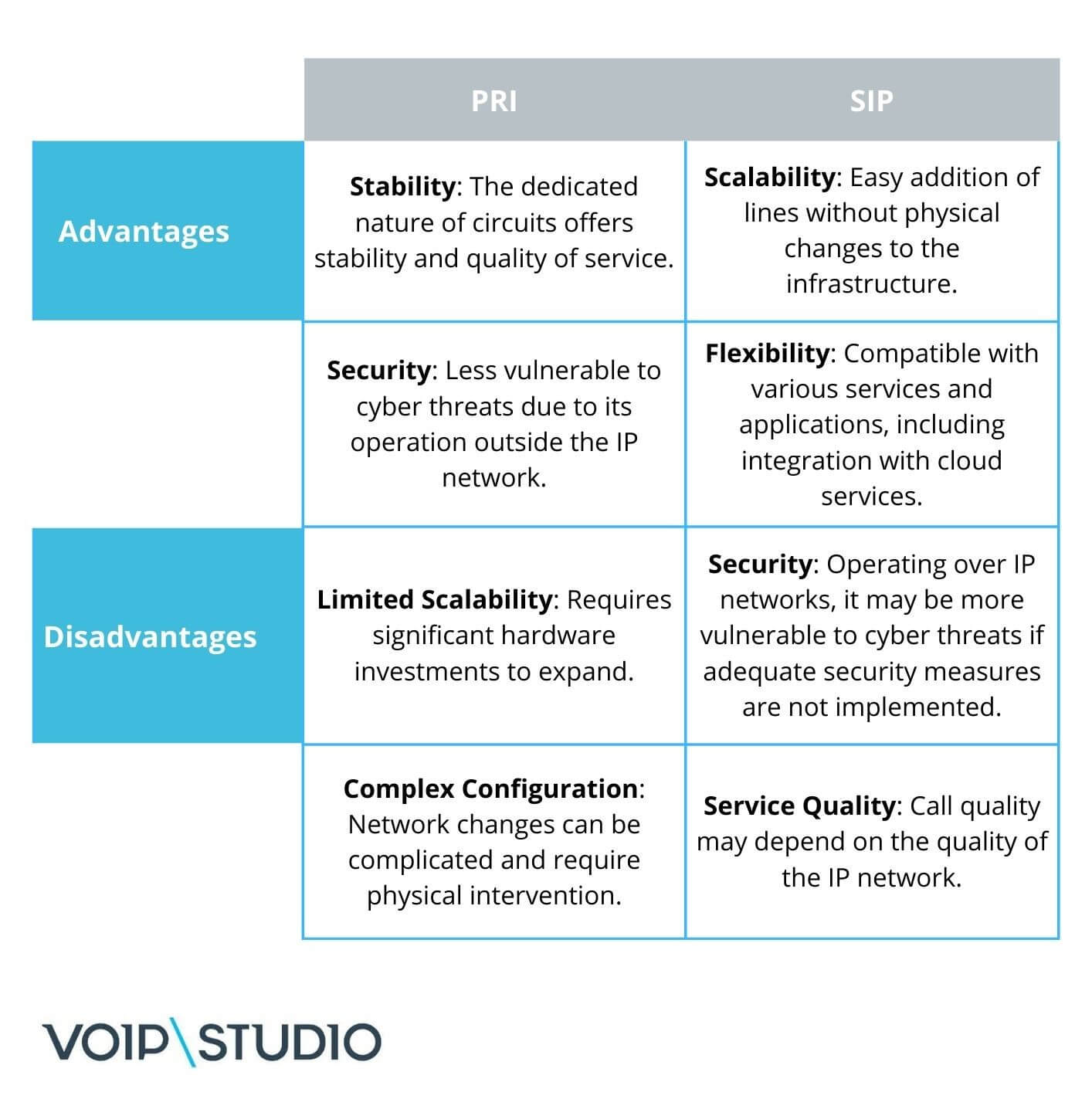
Table of contents
Business communications have been an essential pillar in the evolution of information technologies. In this context, telephony interfaces have facilitated connectivity and data transmission.
As we progress in this digital era, we must understand the transition from traditional technologies to contemporary solutions. In this journey through time and technology, we pause to explore the Primary Rate Interface (PRI), a key piece in business communications.
What is PRI
At its core, PRI is a technical standard that defines the transmission of multiple voice and data channels over a single physical line. To thoroughly understand its operation, it is essential to delve into the details of its definition and structure.
How has PRI been the foundation for business communications in past decades? What is its role in organizational connectivity, and how has it evolved?
Definition of Primary Rate Interface
The Primary Rate Interface (PRI) became an essential standard in business communications. In simple terms, PRI refers to a high-capacity telephone connection type that allows the simultaneous transmission of multiple voice and data channels.
This standard, often associated with T1 and E1 lines, has been fundamental in building robust business telephone networks.
How PRI works and its structure
The functionality of PRI lied in its ability to divide a physical line into multiple channels, each intended to transmit specific information.
We will delve into its technical structure, analyzing how voice and data channels are organized and coordinated for efficient communication.
From channel allocation to digital data transmission, we will understand how PRI has been the backbone of business telephony.
The Primary Rate Interface (PRI) is a standard protocol defining the transmission of multiple voice and data channels over a single physical line. Understanding how PRI works involves exploring its technical intricacies:
Channel division: PRI excels in dividing a physical line into discrete channels, each with a designated purpose. These channels can simultaneously transmit various information types, including voice and data.
Technical structure: At its core, PRI operates based on a time-division multiplexing (TDM) system. It means that different channels utilize the available bandwidth, ensuring efficient use of the communication infrastructure.
Voice and data coordination: The technical architecture of PRI involves a meticulous coordination of voice and data channels. Voice channels carry real-time audio conversations, while data channels transmit digital information.
Channel organization: PRI typically uses a 23B+D or 30B+D channel structure, where “B” represents bearer channels for voice and data, and “D” signifies delta channels for signaling and control information. This structured organization optimizes the use of available bandwidth.
Efficient communication: PRI’s efficiency lies in allocating specific channels for distinct purposes. Bearer channels manage voice and data transmission, ensuring clarity and reliability, while delta channels handle signaling information, facilitating call setup and control.
Digital data transmission: PRI converts analog voice signals into digital data for transmission, enhancing the clarity and quality of communication. This digital transmission also integrates various data services over the same infrastructure.
The backbone of business telephony: PRI has been a foundational element in building resilient business telephony networks by providing a robust framework for the simultaneous transmission of multiple channels over a single line. Its structured approach ensures reliable communication for enterprises.
Understanding the technical intricacies of PRI’s channel division, coordination, and organization sheds light on its role as a reliable and efficient protocol in business telephony. This comprehensive framework has made PRI a cornerstone technology for organizations seeking stable and simultaneous voice and data transmission capabilities.
Traditional uses of PRI
PRI stood out for its reliability and stability as technology evolved, becoming a natural choice for businesses requiring a robust telephone infrastructure. However, as companies sought more flexible and adaptive solutions in the digital era, the transition to technologies like the Session Initiation Protocol (SIP) became inevitable. The following sections will explore this evolution and its implications in the current business communications landscape.
Historical context: When and why PRI was used
In this journey through the evolution of telephony interfaces, we will unravel the secrets of PRI and lay the groundwork for understanding the reasons behind its decline and the transition to more modern technologies like the Session Initiation Protocol (SIP). Join us on this journey where the past, present, and future intertwine in the constant quest for more efficient and adaptable communication solutions to meet growing business demands.
The Primary Rate Interface (PRI) has been a crucial element in the landscape of business communications, especially during the years when traditional telephone infrastructures predominated.
In the mid-to-late 20th century, PRI emerged as an effective response to the growing connectivity needs of businesses. Some key moments in the history of PRI include:
- 1980s: With the increasing demand for phone lines in businesses, PRI establishes itself as an efficient solution to handle multiple simultaneous calls.
- The 1990s: PRI becomes an international standard in an increasingly globalized business environment, enabling reliable communications across borders.
- Early 2000s: As internet technology becomes more accessible, PRI remains the primary choice for businesses requiring robust telephone connectivity.
Common applications in business environments
PRI was essential for various applications in business environments with its ability to handle multiple channels, providing a reliable platform for communications. Some of the most common applications include:
- Business telephone switchboards: PRI served as the backbone for business telephone switchboard systems, allowing efficient management of numerous extensions and lines.
- Call centers: PRI offered the necessary capacity to handle multiple simultaneous interactions in environments with high call volumes, such as call centers and customer service.
- Internal communications: PRI facilitated internal communication in companies with multiple branches or departments by providing dedicated channels for internal and external calls.
- Conference calls: PRI allowed efficient conference calls by giving the capacity to connect multiple lines simultaneously.
- Data transmission: In addition to voice, PRI was also used to transmit data, offering a comprehensive solution for businesses’ communication needs.
Reasons for the disuse of PRI
The Primary Rate Interface (PRI), once the backbone of business communications, has experienced a marked decline in recent years. This shift is attributed to a combination of rapid technological changes and evolution in the needs of businesses.
Below, we will explore the reasons behind this decline and the limitations that eventually led to the disuse of PRI.
Implementation and maintenance costs
The implementation and maintenance of PRI systems involved significant costs, both in hardware and configuration. Companies seeking to reduce costs and improve efficiency have moved away from solutions requiring substantial initial investments.
Complexity in configuration changes
Changing PRI system configurations could be complex, often requiring physical intervention in the infrastructure. It was inconvenient compared to more modern, software-based solutions.
Limitations in adaptability
The limited ability of PRI to quickly adapt to changes in demand and business needs has contributed to its decline. Companies seek solutions that allow them to be agile and respond efficiently to changes in the business environment.
Security and vulnerabilities
With the increase in cyber threats, the inherent security limitations of traditional telephone infrastructures like PRI have driven the search for more secure IP-based solutions.
Understanding these reasons and limitations, companies can make informed decisions about migrating from PRI to more modern technologies, paving the way for more efficient communication adaptable to current demands.
Current alternatives in business telephony: Transition to IP
The constant evolution in the field of business communications has led to the emergence of modern technologies that surpass the limitations of traditional telephone infrastructures like the Primary Rate Interface (PRI).
The Session Initiation Protocol (SIP) is a robust and highly adaptable solution among these alternatives. Below, we will explore the key features of SIP and the advantages offered by current technologies in the landscape of business telephony.
Introduction of modern technologies like SIP
The widespread shift toward data transmission over Internet Protocols (IP) has been a primary reason behind the decline of PRI. Companies seek more flexible and efficient solutions that integrate with their existing data networks.
Session Initiation Protocol (SIP)
SIP has become the predominant standard for IP-based business communications. Based on the request and response model, this protocol facilitates the initiation and management of communication sessions, including voice and video, over IP networks.
Operation over IP networks
Unlike PRI, which uses dedicated circuits, SIP operates over IP networks, allowing the transmission of voice and data through the same infrastructure used for data transmission in the network. It provides unprecedented flexibility and scalability.
Adaptability and scalability
Modern companies require a communication infrastructure that is highly scalable and flexible. Unlike PRI, IP-based technologies like the Session Initiation Protocol (SIP) offer effortless scalability and the ability to adapt quickly to changes in business needs. It facilitates the expansion of lines and services without significant changes to the physical infrastructure.
Integration with cloud services
The growing adoption of cloud services has transformed how companies manage their operations. One highlighted feature of current technologies is their ability to integrate with cloud services seamlessly.
SIP facilitates connection with cloud-based applications and solutions, offering companies access to modern and flexible tools.
Simplified configuration and maintenance
The configuration and maintenance of SIP-based systems are simpler and more manageable than traditional technologies. Changes in the network can be efficiently made through software-based interfaces.
Mobility and remote work
With the proliferation of remote work and employee mobility, companies seek solutions that enable smooth communication outside traditional office locations. With its limitations, PRI needs to catch up with more adaptable technologies.
Differences between PRI and SIP
The transition from more traditional technologies, such as the Primary Rate Interface (PRI), to modern solutions, like the Session Initiation Protocol (SIP), marks a significant milestone in the evolution of business communications. Let’s break down the key differences between PRI and SIP, consider their features and functionalities, and evaluate the advantages and disadvantages of each technology.
Comparison of features and functionalities
Advantages and disadvantages of each technology
Companies can make informed decisions about which technology aligns best with their specific needs based on the differences of each technology. The transition from PRI to SIP drives operational efficiency and the ability to adapt agilely to a constantly changing business environment.
Considerations for migration
The migration from PRI to current technologies involves careful planning and the implementation of strategic steps. Here, we detail vital considerations to facilitate a smooth transition:
Practical steps for the transition from PRI to current technologies
- Assessment of existing infrastructure: Conduct a comprehensive evaluation of the existing PRI infrastructure to understand current and future needs.
- Selection of alternative technology: Identify the most suitable alternative technology, such as SIP, considering the specific needs of the company and its long-term goals.
- Configuration and testing in a pilot environment: Configure and test the new solution in a pilot environment to validate its performance and ensure it meets business requirements.
- Gradual migration: Implement the latest technology gradually, migrating lines and services as the organization adapts and leverages new capabilities.
Factors to consider in planning
- Staff training: Provide adequate training to staff to ensure a smooth transition and maximize the use of new features and capabilities.
- Quality of Service assurance (QoS): Ensure quality of service during and after migration to maintain optimal communication standards.
- Security considerations: Implement robust security measures to safeguard business communications, especially when migrating to IP-based environments.
- Evaluation of providers: Conduct a detailed evaluation of technology and service providers to ensure a reliable and sustainable partnership.
- Contingency plan: Develop a contingency plan to address potential challenges during migration and ensure service continuity.
- Monitoring and continuous improvement: Implement continuous monitoring systems to assess performance and proactively improve as business needs evolve.
By considering these steps and factors, companies can effectively transition to current technologies, ensuring an agile, efficient communication infrastructure aligned with the demands of the current business environment.
VoIPstudio: A comprehensive solution for transitioning from PRI to IP telephony
The transition from traditional solutions like the Primary Rate Interface (PRI) to modern IP Telephony technologies is critical for companies looking to improve their communication infrastructure.
VoIPstudio stands out as a comprehensive solution in this transition process. Here are some reasons supporting the choice of VoIPstudio in this context:
Flexibility and scalability
VoIPstudio seamlessly adapts to the growing needs of companies by offering a highly scalable solution. The ability to efficiently add or reduce lines and services ensures that companies can adjust their communication infrastructure according to changing requirements.
Integration with cloud services
VoIPstudio seamlessly integrates with cloud services in an increasingly cloud-oriented business world. It enhances operational efficiency and allows companies to make the most of cloud-based tools and applications.
Advanced features and cost efficiency
VoIPstudio offers a wide range of advanced features beyond simple voice transmission. From unified messaging to call recording and real-time collaboration, these features enhance the operational efficiency of companies.
Additionally, software-based configuration and integration with the cloud contribute to significant cost efficiency.
Gradual migration and easy configuration
VoIPstudio facilitates a gradual migration, allowing companies to transition progressively without significant disruptions. The ease of configuration and a dedicated support team ensures a smooth implementation and transition.
Quality of service and security
VoIPstudio is committed to high-quality service standards, ensuring an optimal communication experience. Furthermore, it implements robust security measures, crucial in modern business environments, to safeguard communications and sensitive data.
Monitoring and analysis
The VoIPstudio platform offers advanced monitoring and analysis tools, enabling companies to assess and improve their communication infrastructure continually. It is essential for maintaining optimal performance and adapting to changing business demands.
Facilitating remote work and mobility
In a world where mobility and remote work are imperative, VoIPstudio provides solutions that enable effective communication from anywhere. It ensures constant connectivity, regardless of physical location.
In summary, VoIPstudio is a comprehensive solution for companies seeking a successful transition from PRI to cutting-edge IP Telephony technologies.
Try VoIPstudio for free. It is your perfect strategic ally in improving your business communication infrastructure.
More from the blog
Want to improve your business communication?
Unlock enterprise-class call center power at affordable prices – no hardware, no delays, no surprises!








